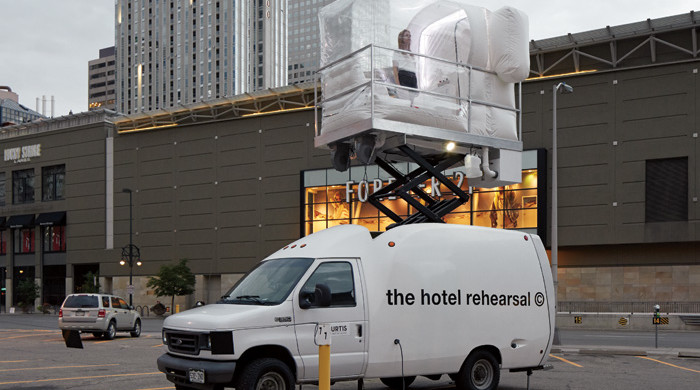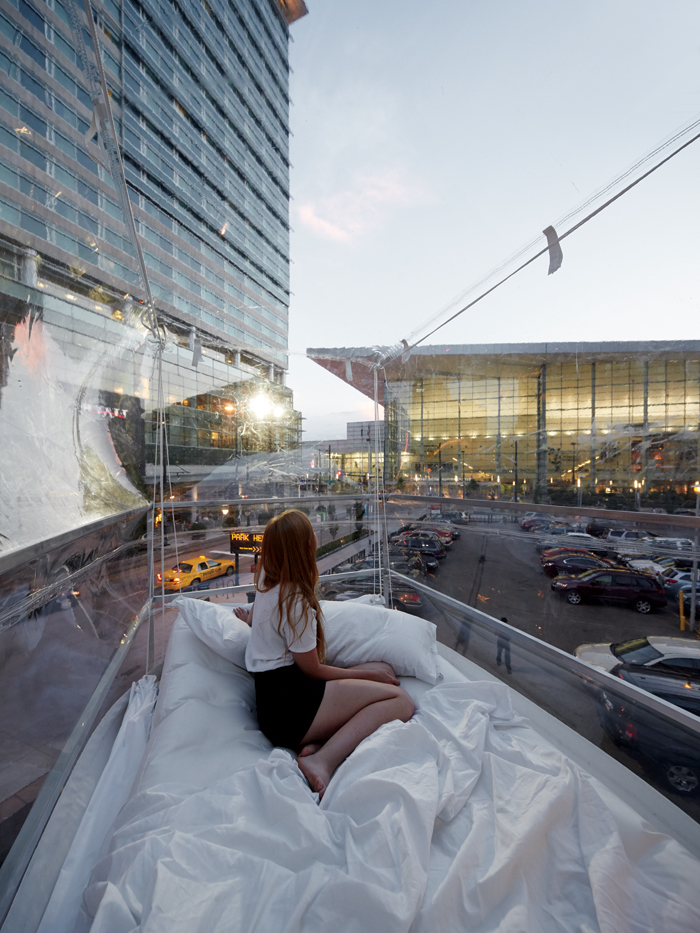Charlotte Meyer: The Hotel Rehearsal contains all the elements of your previous work; architectural space, the dynamics of living in the public, revealing habits that sometimes we keep hidden—but in contrast it takes on popular culture in a seamless presentation. You have created a completely transparent hotel room containing little more than a bed/sofa raised into the sky by a scissor lift, from the back of a parked van.
Alex Schweder: Yeah one of the things I’m trying to get to in recent works, is how do you include popular culture? How do you include everyone in the work so that it becomes much more about the person’s experience than me disseminating an idea, they come to it and make it their own?
CM: So that’s deliberate, how do you reach as many people as possible?
AS: Exactly, what is going to titillate people so that they want to come and play in this little floating room? It exists in this pop up world which is only a 5 x 7 space, the bed inflates and pushes the sofa shut, this back and forth, this little soft space.
CM: The thing that is incredible about the work is that you have taken the idea of the hotel—a place to sleep, to deflate, to take care of yourself, to have the space be as desirable as possible. Its sexy to spend a night in a hotel room, although you are taking away some of the comforts, like a bathtub. Instead you make it into a viewing space, having a window view in one’s chosen destination would inherently be the best possible scenario, and you have done that on a 360-degree rotation.
AS: And it was important to me being able to sleep in this space in the middle of the city and look up at the sky. The curtains come up at night. It’s not usually a view we think of when thinking of an urban space, just the sky, and the parking lot is one of the few open spaces in the city.
CM: This parking lot theme suggests that it’s a portable hotel and that you can take it with you wherever you want to go.
AS: I can take it wherever I want to take it.
CM: The scissor lift is also an icon of popular culture. They are used everywhere, in construction all over New York, but we might not notice them. You are bringing attention to something that is quite literally happening all around us in this city, being under construction constantly. Is that how it functions architecturally for you?
AS: Yes, the van and the scissor lift combine the two most common modes of transportation, the elevator and the automobile. So, you’ve got the vertical and horizontal in the same piece, that moveable opposite is a distinctly urban piece.
CM: How high could you get the piece, not just how high does the lift go but how far up could you drive the piece? Hypothetically could you drive to the top of a hill or a six-story parking lot.
AS: One of the decisions has to do with defining it as a distinctly urban piece, not a rural piece at all. I could have added a generator but it relies on a regular outlet for power.
CM: You wanted the city experience.
AS: It basically ties in to the city through this umbilical cord, on the side of the van is this little plug and you have to find an outlet. Every parking lot that I visited has an outlet somewhere; you have to look for it because it’s not something you think about. It’s like a little building that has an umbilical cord to the city.
CM: Is your interest focused solely on bodies in buildings?
AS: That, and the performative nature of the work—the understanding of the city as something that you can practice and rehearse. Basically, the parking lots are open spaces; they are potential buildings, and the hotel is just one of the many types of possible buildings that could go into a parking lot. I chose a hotel. I made this little hotel based on the desire of this site. What I like about the parking lot is that you can drive something in and you can practice. It’s a kind of autonomous thing; it could be a hotel, a library, any number of inserts, and that for me was really exciting about the parking lot.
CM: Which is curious when considering perception and physical awareness of space and how you get to thinking that a parking lot has desirability. The idea of what people generally consider a parking lot to be in terms of an aesthetic, you are turning that around. The temperament of how a parking lot is represented in ones mind is not usually rife with possibility. How did you get to that thought system?
AS: I’ve been working with parking lots for quite some time. When I was in graduate school doing my research I chose parking lots because there is nowhere to go but up in terms of making them interesting, usually it’s just a totally functional place. Questions arose as to why you would go there, why would you go to a parking lot as an experience. I had 16 parking lots in the underground city, in its ruinous landscape that no one can access, and if you open that landscape up and give it a lobotomy, you can make it safe for people. With a car you’ve got this little zone of safety through which you can drive into a dangerous landscape or a landscape which is not pretty and thereby charged—you have this pocket of safety in a danger zone. It became a way of cleaning up something that was ugly and seeing that treacherous area as something that you want to see.
CM: How does the performative aspect tie into the piece?
AS: I have been working with performance architecture for about seven years, studying how you perform the space. For instance, the wall texts that I put on the walls in the Chinati Foundation residency, a body of work called Architectural Performances in Geological Times, were a set of instructions. I had two studios in Chinati, the locker plant and the ice plant, which used to be butcher shop. What’s interesting about that is there was this sunny space facing the sidewalk and then just behind it was the meat locker, which is completely cool with thick walls. Without having mechanical cooling it was about 10 degrees cooler in the dark room than it was in the sunny room, so one of the instructions that I came up with, was: “inhale this warmer room and exhale it into the cooler room until their temperatures are the same.” Your body takes over the room and shifts that bit of warm space again and again, but its not like you would ever accomplish or realize this change.
CM: Its about being cognizant about what that means, taking a moment to actually think about what your body is doing in space.




















